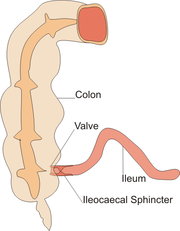

| Sphincter | |
|---|---|
| Identifiers | |
| TA98 | A04.0.00.028 |
| TA2 | 1992 |
| FMA | 75004 |
| Anatomical terms of muscle | |
Asphincter is a circular muscle that normally maintains constriction of a natural body passage or orifice and which relaxes as required by normal physiological functioning. Sphincters are found in many animals. There are over 60 types in the human body,[citation needed] some microscopically small, in particular the millions of precapillary sphincters.[1] Sphincters relax at death, often releasing fluids and faeces.[2]
Each sphincter is associated with the lumen (opening) it surrounds. As long as the sphincter muscle is contracted, its length is shortened and the lumen is constricted (closed). Relaxation of the muscle causes it to lengthen, opening the lumen and allowing the passage of liquids, solids, or gases.
This is evident, for example, in the blowholes of numerous marine mammals.
Many sphincters are used every day in the normal course of digestion. For example, the lower oesophageal sphincter (or cardiac sphincter), which resides at the top of the stomach, is closed most of the time, keeping acids and other stomach contents from pushing up and into the oesophagus, but opens to let swallowed food pass into the stomach.
Sphincters can be further classified into functional and anatomical sphincters:[citation needed]
Sphincters can also be voluntarily or involuntarily controlled:

| National |
|
|---|---|
| Other |
|